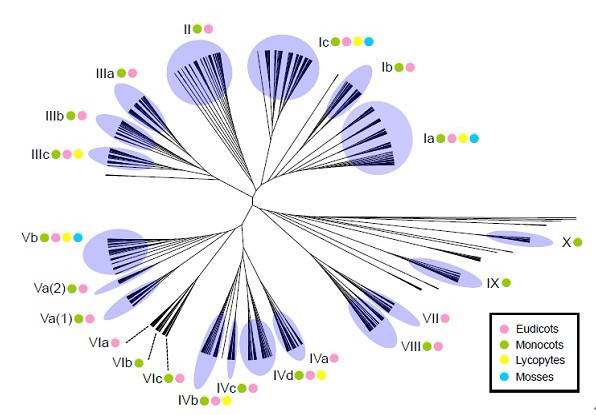Name:
Tell:
Email:
Organization:
Evolutionary History of NAC Proteins in Plants Revealed by WBG Scientists
2012-02-24
NAC (NAM/ATAF/CUC) proteins are one of the largest groups of transcription factors in plants and involved in diverse regulatory processes during the plant’s development. Although many NAC proteins in different species and classifications based on Arabidopsis and rice genomes have been reported, a complete survey and classification of all NAC genes in plant species from disparate evolutionary groups is lacking.
In order to unveil the relationships between NAC proteins, Prof. PENG Junhua and his PH.D. student ZHU Tingting at Wuhan Botanical Garden (WBG), Chinese Academy of Sciences investigated whole-genome sequences from nine major lineages of land plants. Their results showed that there are fewer than 30 NAC proteins present in both mosses and lycophytes, whereas more than 100 were found in most of the angiosperms. Phylogenetic analysis suggests that NAC proteins consist of 21 subfamilies, most of which have highly conserved non-NAC domain motifs. Six of these subfamilies exist in primitive terrestrial plants, whereas the others only diverged among angiosperms.
This study have established the evolutionary backbone of the NAC protein family in plants, and primarily uncovered its intricate evolutionary history. WBG scientists hypothesized that NAC proteins probably originated sometime over 400 million years ago and mainly expanded together with the differentiation of plants into organisms of increasing complexity possibly after the divergence of lycophytes from the other vascular plants.
The study entitled “Phylogenetic analyses unravel the evolutionary history of NAC proteins in plants” has been published in Evolution (doi:10.1111/j.1558-5646.2011.01553.x). This research was jointly funded by the China National Science Foundation (NSFC) (Nos. 31030055 and 30870233), Chinese Academy of Sciences under the Important Directional Program of Knowledge Innovation Project (No. KSCX2-YW-Z-0722), the CAS Strategic Priority Research Program (No. XDA05130403), the “973” National Key Basic Research Program (No. 2009CB118300), and the Ancell Teicher Research Foundation for Genetics and Molecular Evolution.
Article link: http://onlinelibrary.wiley.com/doi/10.1111/j.1558-5646.2011.01553.x/full

Figure Maximum likelihood analysis of 837 NAC protein sequences, shown as an unrooted cladogram. The blue balloons delineate the 21 subfamilies of NAC proteins. Colored dots symbolize the species to which the proteins in each group belong (green: Oryza sativa, Sorghum bicolor, Zea mays [monocot]; pink: Arabidopsis thaliana, Populus trichocarpa, Vitis vinifera, Carica papaya [eudicot]; yellow: Selaginella moellendorffii [lycophyte]; blue: Physcomitrella patens [moss]) (Image by ZHU Tingting)